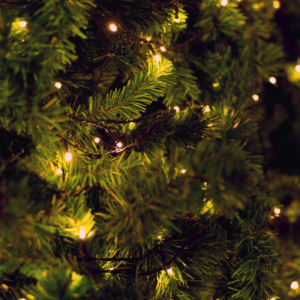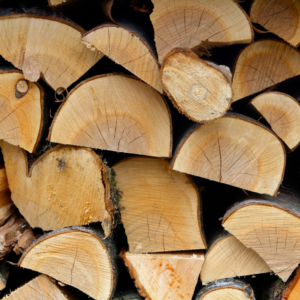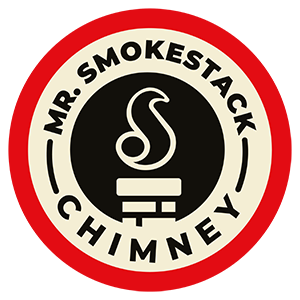Clearing out the Christmas decorations to greet the new year? If you’re deciding what to do with your Christmas tree now that the season is over, you might think your fireplace is a strong option. After all, wood is the intended fuel for your wood-burning unit, right? But there are significant safety reasons NOT to burn your Christmas tree when the holidays are over.
…there are significant safety reasons NOT to burn your Christmas tree when the holidays are over.
The Dangers of Burning Your Christmas Tree
 🎄 Christmas trees are too fresh – aka too wet.
🎄 Christmas trees are too fresh – aka too wet.
Your Christmas tree almost certainly hasn’t been properly seasoned, no matter how dry it may look. And while this means that it may not burn completely, it will still burn hot.
🎄 Christmas trees hold sap and resin.
Species of evergreen such as firs, pines, and spruces, are some of the most popular Christmas tree varieties. These also tend to have a high content of resin and sap, which cause them to burn with intensity. Quick and fierce fires are harder to contain and control.
🎄 Christmas tree needles produce sparks.
The needles from a Christmas tree also burn quickly, and they produce sparks. The light weight of pine needles makes them more likely to escape fireplaces as they burn, either into your living space or up the chimney. These sparks can damage furnishings, rugs, or other items they can strike, or cause an uncontained fire in your living space, chimney, or roof.
🎄 Christmas trees burn with an intensity that’s dangerous.
A fire fueled by a Christmas tree can become very difficult to control, and the risk of fire is greatly increased. In addition to this, the thermal shock of the quick, extreme temperature change can damage your chimney system.
Can I Burn Other Holiday Trash?
Again, there’s no good fuel source for your wood burning fireplace, insert, or stove except seasoned firewood. While it may seem handy and harmless to burn other items, this isn’t the case.
Lightweight items such as gift wrap can act similarly to evergreen needles, carrying sparks up the fireplace flue where accumulated soot or creosote can be ignited. Also, many items – like plastic, colored paper, painted or treated wood, cardboard, paper plates, etc. – can contain chemicals that are toxic when released as they burn.
Long story short? Dispose of your wrapping paper, ribbons, bows, plastic cutlery, and the like properly – and leave them out of your fireplace.
Seasoned Wood Is the Only Fuel for Your Fires
If there were a list of things not to burn in your fireplace, it would be virtually infinite. On the other hand, there’s really only one fuel that’s ideal for an in-home fireplace, and that’s seasoned firewood.
Firewood that’s been seasoned is simply firewood that’s been dried over time. When cut, firewood has a high moisture content that makes it unsuitable for burning in a fireplace. The excessive water leads to incomplete combustion of the firewood, yielding a smokier fire with more creosote build up and cooler flue gases. These are undesirable effects, compromising air quality and increasing risk of uncontained fires.
Firewood that’s been seasoned, on the other hand, has a lower moisture content. The fire uses less energy burning off water, so it burns more completely and cleanly – resulting in less creosote accumulation and hotter gases that properly vent.
Want to know how to test your firewood for readiness?
 Check the ends. Logs will have checking – splits and cracks – and the cut edges may also appear darkened.
Check the ends. Logs will have checking – splits and cracks – and the cut edges may also appear darkened. - Observe the color of the logs. The color won’t contain any of the greenness of newly cut wood, but will be a pale beige.
- Take a listen. You can also check by sound. If you strike one piece of firewood against another, the sound produced should be a hollow knock rather than a dull thunk.
- Test their weight. When lifting the logs, they should feel lighter than newly cut pieces due to the relatively low moisture content.
- Invest in a moisture meter. These are fairly inexpensive and simple to use. Available at hardware and other home improvement stores, a moisture meter will give you a reading of your firewood’s water content. Firewood that’s ready to use will have a moisture content between 15-25 percent.
You can also season your own firewood. Seasoning firewood takes time, but the amount of time depends on the species of wood and other factors, such as amount of exposure to circulating air. Typically, 6 – 12 months is the right window.
Seasoning is aided by the way logs are cut and stored. They’re cut to an appropriate length, split, and stored with the top covered to shield from rain, but the sides open to the wind and sun.
Call Our Experts for Your Fireplace Needs
Safety, comfort, and customer service are our top priorities. We’ve proud of the experience and level of customer service we bring to the table. If you suspect damage to your fireplace system, need routine maintenance, or have questions about proper use and care of your fireplace, we’re happy to be your friendly local experts!
Call 919-747-1859 or request your appointment online today.
